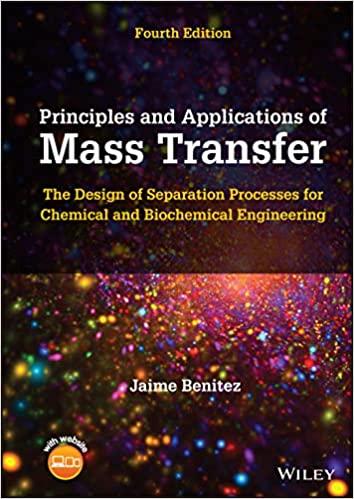Pervaporation (PV) is a membrane-separation process in which one or more components of a liquid mixture diffuse
Question:
Pervaporation (PV) is a membrane-separation process in which one or more components of a liquid mixture diffuse through a selective membrane, evaporate under low pressure on the downstream side, and are removed by a vacuum pump or a chilled condenser (McCabe et al., 2005). Composite membranes are used with the dense layer in contact with the liquid and the porous supporting layer exposed to the vapor. A frequently used PV model is that of Wijmans and Baker (1993). They express the driving force for diffusion across the membrane as a partial-pressure difference \(\left(\gamma_{A} x_{A} P_{A}-y_{A} P_{2}\right)\), where \(x\) and \(y\) are mol fractions in the liquid and gas, \(P_{A}\) is the vapor pressure of component \(\mathrm{A}\) at the temperature of the liquid, and \(P_{2}\) is the total pressure on the permeate side of the membrane.
The first commercial application of PV was for ethanol purification. The dilute ethanol solution produced by fermentation is distilled to produce an overhead product with 90 to \(95 \mathrm{wt} \%\) alcohol (close to the azeotrope). This solution is fed to the PV unit where water is selectively removed to give nearly pure ethanol (99.9 wt\%). The permeate stream, with about 20 to \(40 \mathrm{wt} \%\) alcohol is recycled to the distillation column.
Laboratory tests of a PV membrane exposed to a liquid with \(77.9 \mathrm{~mol} \%\) ethanol in water at \(333 \mathrm{~K}\) showed a flux of \(0.20 \mathrm{~kg} / \mathrm{m}^{2} \cdot \mathrm{h}\) and a permeate composition of \(2.9 \mathrm{~mol} \%\) ethanol when the downstream pressure was \(2.0 \mathrm{kPa}\). Calculate the permeance of the membrane to ethanol and to water at the test conditions.
Liquid-phase activity coefficients at \(333 \mathrm{~K}\) for the ethanol (1)-water (2) system are given by the Van Laar equations (Seader and Henley, 2006):

Step by Step Answer:






